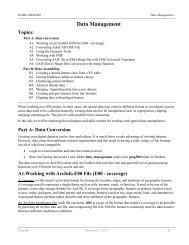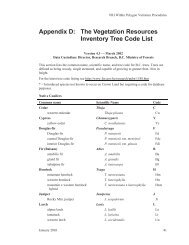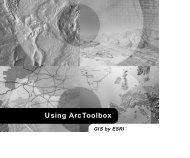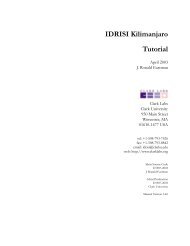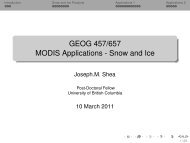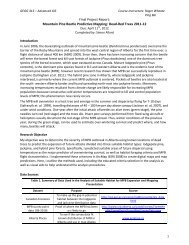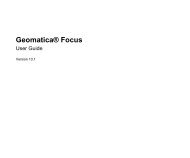Understanding Map Projections
Understanding Map Projections
Understanding Map Projections
Create successful ePaper yourself
Turn your PDF publications into a flip-book with our unique Google optimized e-Paper software.
HOTINE OBLIQUE MERCATOR<br />
LINEAR GRATICULES<br />
Two meridians 180 degrees apart.<br />
PROPERTIES<br />
Shape<br />
Conformal. Local shapes are true.<br />
Area<br />
Distortion increases with distance from the central<br />
line.<br />
Direction<br />
Local angles are correct.<br />
The State Plane Coordinate System uses Hotine Azimuth Natural<br />
Origin for the Alaskan panhandle.<br />
DESCRIPTION<br />
Also known as Oblique Cylindrical Orthomorphic.<br />
This is an oblique rotation of the Mercator<br />
projection. Developed for conformal mapping of<br />
areas that are obliquely oriented and do not follow a<br />
north–south or east–west trend.<br />
PROJECTION METHOD<br />
Cylindrical. Oblique aspect of the Mercator<br />
projection. Oblique Mercator has several different<br />
types. You can define the tilt of the projection by<br />
either specifying two points or a point and an angle<br />
measuring east of north (the azimuth).<br />
Distance<br />
True along the chosen central line.<br />
LIMITATIONS<br />
Use should be limited to regions near the central<br />
line. When using an ellipsoid, constant scale along<br />
the central line and perfect conformality cannot be<br />
maintained simultaneously.<br />
USES AND APPLICATIONS<br />
Ideal for conformal mapping of regions that have an<br />
oblique orientation.<br />
Used for large-scale mapping in the Alaskan<br />
panhandle. Switzerland uses a different<br />
implementation of Oblique Mercator by Rosenmund,<br />
while Madagascar uses the Laborde version. These<br />
implementations aren’t compatible.<br />
By default, the coordinate origin of the projected<br />
coordinates is located where the central line of the<br />
projection crosses the equator. As an example, if you<br />
use an Oblique Mercator (natural origin) for West<br />
Virginia, while the center of the projection is -80.75,<br />
38.5, the natural origin is approximately -112.8253,<br />
0.0. You can move the projection origin to the center<br />
of your data by using the Two-Point Center or<br />
Azimuth Center cases.<br />
LINE OF TANGENCY<br />
A single oblique great-circle line or secancy along<br />
two oblique small circles parallel to and equidistant<br />
from the central great circle.<br />
Supported map projections• 63




